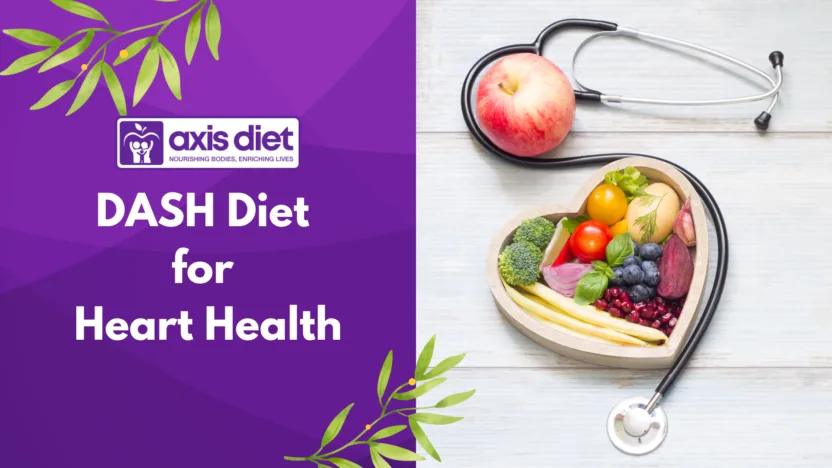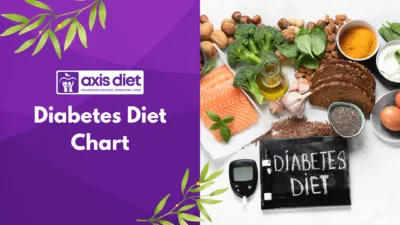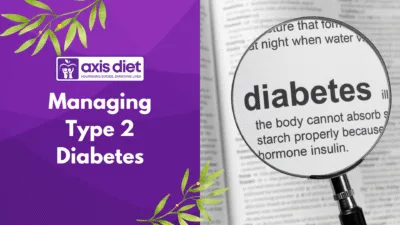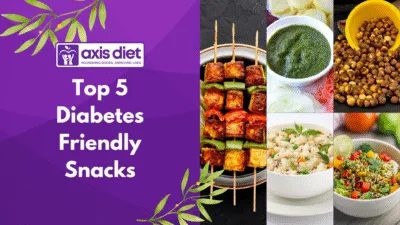The Indian DASH diet plan combines the principles of the DASH diet with traditional Indian food to promote heart health. This 7-day meal plan emphasizes whole grains, fruits, vegetables, and healthy fats, making it a flavorful yet nutritious choice. Let’s explore the details of this plan and how it can contribute to better cardiovascular wellness.
What we’ll learn,
Understanding the DASH Diet
The DASH diet, or Dietary Approaches to Stop Hypertension, started as a dietary intervention to combat high blood pressure. It was developed through a series of clinical studies and has become a cornerstone in heart health promotion. Evidence shows that the DASH diet effectively reduces hypertension through its structured eating principles. The diet encourages a low intake of sodium while highlighting the importance of nutrient-rich foods.
One of the fundamental pillars of the DASH diet is its emphasis on low sodium intake. Consuming fewer than 2,300 mg of sodium per day can significantly lower blood pressure levels, while a more restricted intake of 1,500 mg is even more beneficial for at-risk individuals. In place of sodium, the diet encourages flavor enhancement through an array of natural, wholesome ingredients.
The DASH diet also prioritizes fruits, vegetables, whole grains, and lean proteins. By incorporating these components, the diet boosts essential vitamins and minerals, helping to improve overall health. Specific foods, such as leafy greens, berries, whole grain cereals, legumes, and lean meats like chicken and fish, are cornerstone elements of the program. These foods help improve heart function, reduce cholesterol levels, and strengthen blood vessel elasticity.
The DASH diet emphasizes a balance of food groups to ensure nutrient diversity. For instance, it includes:
- 4-5 servings of fruits each day
- 4-5 servings of vegetables daily
- 6-8 servings of whole grains
- 2 or fewer servings of lean meats or fish
- Nuts, seeds, and legumes several times a week
These recommendations come together to create a sustainable eating pattern that aligns perfectly with heart health goals. The DASH diet’s effectiveness does not lie solely in its structure but also in its flexibility. Individuals can adopt this dietary approach without extensive meal preparation complexity.
For those looking to transition to the DASH diet, understanding its core principles is crucial. Adopting a diet rich in fruits and vegetables while reducing sodium allows one to harness numerous health benefits. Thus, it is not merely about dietary restrictions but rather embracing a new palette of flavors and nutrition.
For more insights on healthy eating tailored to heart health, you can refer to a related topic here: Diet for High Blood Pressure.
The Importance of Indian Cuisine in the DASH Diet
Indian cuisine offers a plethora of flavors and delights that can be expertly molded to align with the DASH diet guidelines. This adaptability not only satisfies the palate but also promotes heart health, as specified by DASH principles, including low sodium intake and a high consumption of fruits, vegetables, whole grains, and lean proteins. It should thus come as no surprise that one can relish authentic Indian dishes while reaping health benefits.
Traditional Indian cooking emphasizes the use of spices and herbs that not only elevate dishes in terms of flavor but also serve various health benefits. Spices like turmeric, known for its anti-inflammatory properties, ginger, which aids digestion, and cumin, promoting better metabolism, are staples in Indian kitchens. Utilizing these spices instead of salt can enhance the sensory experience of meals without jeopardizing health.
Additionally, ingredients such as garlic and green chilies can be used generously to boost flavor. Garlic is praised for its cardiovascular benefits, including cholesterol reduction and blood pressure management. Similarly, fresh herbs like cilantro and mint not only add a refreshing touch to dishes but also contribute vital nutrients.
Cooking methods in Indian cuisine further complement the DASH diet. Techniques such as steaming, grilling, and sautéing using minimal oil can maintain the nutritional integrity of food. For example, instead of heavy frying, one could opt for tandoori cooking, which allows meats and vegetables to be cooked at high temperatures in a clay oven, resulting in tender dishes that do not require excessive fat.
Grains, which form the foundation of many Indian meals, can be heart-healthy options. Whole grains like brown rice, quinoa, and whole wheat flour can replace their refined counterparts. Lentils and legumes, such as chickpeas and black beans, are excellent sources of lean protein and are naturally low in sodium. These foods are not only filling but rich in fiber, which is essential for heart health.
Furthermore, Indian dishes often include a vibrant array of vegetables, which are essential in the DASH diet. Incorporating seasonal vegetables like spinach, cauliflower, and bell peppers into meals can amplify the nutritional density. From curries to stir-fries, the possibilities for creating heart-healthy meals are limitless.
In conclusion, adapting traditional Indian cuisine for the DASH diet is a delightful journey rich in flavors and health benefits. The culinary practices rooted in Indian culture naturally align with the core principles of DASH, making it easier to embrace a heart-healthy lifestyle while enjoying the rich tapestry of Indian flavors. For more insights on cooking with spices that can enhance health, check out this article on cooking with spices.
7-Day Indian DASH Diet Meal Plan Overview
The 7-Day Indian DASH Diet Meal Plan focuses on maintaining heart health through eating balanced meals that are rich in nutrients. This plan emphasizes whole foods, lean proteins, and optimal portion sizes to ensure the body receives all necessary vitamins and minerals. Below is a breakdown of the plan, including daily meals, snacks, and beverages.
Each day of the plan consists of three main meals—breakfast, lunch, and dinner—along with two snacks and hydration guidelines. The meals are crafted to stay within the DASH diet framework while embracing the flavors and ingredients of Indian cuisine.
- Breakfast: Focus on whole grains, fruits, and low-fat dairy. Options may include oats with almonds, fruit smoothies, or whole wheat poha.
- Lunch: Incorporate lean proteins and vegetables. Dishes might include dal with brown rice, chickpea salad, or mixed vegetable curry paired with whole grain roti.
- Dinner: Emphasize lighter portions with a mix of protein and vegetables. Possible meals could be grilled fish with spinach or vegetable stir-fry with tofu.
- Snacks: Nutritious and satisfying choices include carrot sticks with hummus, yogurt with fruits, or a handful of mixed nuts. Aim to keep snacks around 150-200 calories.
- Beverages: Hydration is essential. Opt for water, herbal teas, and limit caffeine intake. Avoid sugary drinks.
Each meal is designed with portion control in mind, which is crucial for heart health. Portion sizes are tailored to individual needs while keeping calorie intake aligned with DASH guidelines. A typical portion may consist of:
- 1/2 cup of cooked grains
- 1 cup of vegetables
- 3-4 ounces of protein
- 1 small serving of fruit
This balance between food groups ensures that the diet is not only heart-healthy but also rich in flavor and satisfaction. Nutrient balance plays a key role in this plan, with a focus on reducing sodium and added sugars. Instead, healthy spices and herbs stand as natural flavor enhancers, preserving the essence of traditional Indian cuisine.
By adhering to this structured meal plan, individuals can actively work towards better heart health while enjoying diverse and flavorful Indian dishes. Those looking for more on how to manage calorie intake can consult healthy eating portion control.
Day 1: Kickstarting Your Journey
Kickstarting your journey on the Indian DASH diet begins with a focus on wholesome flavors and heart-healthy ingredients. Day 1 delivers exciting meals, setting a vibrant tone for the week ahead. Each meal is designed to adhere to the DASH diet principles, prominently emphasizing fruits, vegetables, whole grains, and lean proteins, while being low in sodium.
For breakfast, start the day with a bowl of oats poha. This innovative dish combines flattened rice with oats, mixed with sautéed mustard seeds, curry leaves, and a colorful assortment of vegetables like peas, carrots, and bell peppers. Garnish with fresh coriander and a squeeze of lemon for added flavor. This powerful mix not only keeps you full but also provides a good source of fiber essential for heart health. Pair it with a glass of buttermilk, rich in probiotics, which supports digestive health while being low in calories.
Lunchtime is all about balancing flavors and nutrients. Prepare a dal palak, a nutritious lentil dish cooked with spinach and seasoned with cumin and turmeric. This light meal can be served with a small portion of brown rice, which offers more fiber than white rice. Add a side of cucumber raita, made from low-fat yogurt and grated cucumber, to cool your palate and enhance digestion. This combination effectively provides protein and essential minerals while keeping sodium levels in check.
As the day winds down, indulge in a comforting vegetable khichdi for dinner. This one-pot meal made with moong dal and mixed veggies like carrots, peas, and zucchini ensures a hearty yet light dish. Season it with turmeric and ginger for added benefits. Serve it with a side of steamed broccoli and a drizzle of lemon juice to elevate flavor without compromising heart health.
Throughout the day, you can include nutritious snacks. Consider a handful of unsalted nuts, such as almonds or walnuts, to get healthy fats and protein. Another option is fresh seasonal fruit, like papaya or pomegranate, which are both delicious and packed with antioxidants.
This well-rounded approach for Day 1 not only nourishes your body but also ignites your passion for healthy eating. By focusing on whole foods and minimizing processed items, you lay a strong foundation for the days to follow. For more insight on heart-healthy meals, explore heart-healthy meals for busy people.
Day 2: Exploring New Flavors
On Day 2 of the Indian DASH Diet Meal Plan, the focus shifts to exploring new flavors that harmonize with heart health. The meals for the day will revolve around legumes, vegetables, and spices that benefit cardiovascular wellness. Each meal is designed to be nutritious while celebrating the rich tastes of traditional Indian cuisine.
Breakfast: Start the day with a classic Masoor Dal Chilla. Blend soaked red lentils with green chilies, ginger, and spices until smooth. Cook on a non-stick skillet with minimal oil until crisp. Serve with a side of fresh coriander chutney for a zesty kick. This dish is high in protein and fiber, essential for heart health. Include a bowl of fresh seasonal fruit, like papaya or orange slices, to complete your breakfast.
Mid-Morning Snack: A small serving of Roasted Chickpeas sprinkled with chaat masala can provide a crunchy, satisfying snack. The fiber in chickpeas helps lower cholesterol levels, making them an excellent choice for heart health.
Lunch: Prepare a wholesome Palak Chole. Cook chickpeas with spinach, tomatoes, and a blend of spices like cumin and garam masala. This dish is rich in iron and antioxidants. Pair it with Brown Rice, which offers essential nutrients and keeps the meal balanced. To round off the lunch, enjoy a refreshing cucumber and tomato salad seasoned with lemon juice and coriander.
Afternoon Snack: Opt for a handful of mixed nuts, such as almonds and walnuts. These nuts are rich in omega-3 fatty acids, beneficial for heart health. A cup of green tea can complement this snack, providing antioxidants and hydration.
Dinner: For dinner, enjoy a hearty Vegetable Khichdi made with millet and mixed vegetables like carrots, beans, and peas. Use turmeric and ginger for flavor and health benefits. Cook all ingredients with low-sodium vegetable broth for added taste. Serve with a side of Cabbage Sabzi, sautéed with mustard seeds and curry leaves, which adds a delightful crunch and is rich in nutrients.
To incorporate the benefits of spices like turmeric and ginger, sprinkle them liberally in your meals. Not only do they add flavor, but they also possess properties that promote heart health. The use of legumes in meals further enhances fiber intake, essential for lowering blood pressure and cholesterol levels.
Explore more about the nutritional benefits of legumes and their role in a heart-healthy diet in this insightful article on Plant-Based Cholesterol Diet.
Day 3: Nutrient-Rich Ingredients
Day 3 focuses on enriching meals with whole grains and healthy fats, key elements in promoting heart health. Whole grains are packed with fiber, which helps lower cholesterol levels and maintain heart function, while healthy fats, such as those found in nuts and seeds, contribute to improved heart health by reducing inflammation and lowering bad cholesterol.
For breakfast, a delightful Oats Upma can be prepared. This recipe combines rolled oats with vegetables, offering a nutritious start to the day.
- Ingredients: 1 cup rolled oats, 1 onion (chopped), 1 tomato (chopped), 1 carrot (grated), ½ cup green peas, mustard seeds, curry leaves, turmeric, salt, and green chilies (to taste).
- Instructions: Dry roast the oats until golden, then set aside. In a pan, heat a teaspoon of healthy oil, add mustard seeds, curry leaves, and onions. Once the onions are translucent, add tomatoes, curry leaves, grated carrot, and peas. Stir well, then add the oats and water. Cook until the oats are soft. Serve hot.
This dish not only provides fiber but also various vitamins and minerals, making it ideal for heart health.
For lunch, prepare a Quinoa Salad. Quinoa is a complete protein and a perfect substitute for rice. This salad can be a refreshing addition to your meal plan.
- Ingredients: 1 cup cooked quinoa, ½ cup cucumber (diced), ½ cup bell pepper (diced), ½ cup cherry tomatoes (halved), lemon juice, olive oil, salt, black pepper, and fresh herbs (like basil or parsley).
- Instructions: In a large bowl, combine the quinoa, cucumber, bell pepper, and cherry tomatoes. Drizzle with lemon juice and olive oil, then season with salt and pepper. Toss gently and garnish with fresh herbs.
The combination of quinoa and vegetables not only increases nutrient density but also provides a satisfying meal that supports heart health.
For dinner, enjoy Whole Wheat Roti with Avocado Chutney. Whole wheat increases fiber intake, while avocados are rich in monounsaturated fats.
- Ingredients: 1 cup whole wheat flour, water (to knead the dough), 1 ripe avocado, 1 small lemon (juiced), cilantro, salt, and green chili.
- Instructions: Knead the whole wheat flour into a soft dough. Roll out the roti and cook on a hot pan until golden brown on both sides. For the chutney, mash the avocado and mix with lemon juice, finely chopped cilantro, salt, and minced green chili. Serve the roti warm with the chutney.
This meal offers heart-healthy fats from the avocado and the benefits of whole grains from the roti.
The meals for Day 3 emphasize the importance of whole grains and healthy fats in heart health. By integrating these nutrient-rich ingredients, a balanced diet supporting cardiovascular health is well within reach. For more insights on heart-healthy meals, visit heart-healthy meals.
Day 4 to Day 7: Continuing the Journey
Days 4 to 7 of the Indian DASH diet meal plan continue to build on the healthy foundations laid in the first half of the week. By now, you have explored the richness of whole grains and healthy fats. As you progress into the latter days, it’s crucial to maintain not just the nutritional balance, but also the variety that keeps meals exciting and satisfying.
During these days, you can incorporate more seasonal vegetables and fruits to enhance your meals. Options like spinach, broccoli, and bell peppers are not only nutrient-dense but also vibrant in color, making your plates visually appealing. Include a mix of lentils, beans, and legumes to provide essential plant protein. For example, prepare a mixed dal with spices and fresh herbs, serving it over a base of whole grain rice or quinoa.
Snacks can be varied, too. Opt for roasted chickpeas or a handful of nuts to keep your energy levels stable between meals. Smoothies made from low-fat yogurt and seasonal fruits can be a delightful yet nutritious treat.
Meal prepping is an essential strategy for success. Dedicate time at the beginning of the week to wash, chop, and store your vegetables. Cook larger batches of grains and legumes, then store them in your refrigerator. This way, you can quickly assemble meals without a lot of effort. For instance, a big pot of quinoa can easily convert into salads, stir-fry dishes, or even added to soups for various meals.
Adjusting recipes allows you to keep meals enjoyable. Experiment with different spices and cooking techniques. Try steaming or grilling vegetables for a new texture and flavor. If a recipe calls for yogurt, you can switch to buttermilk or create a raita using seasonal fruits.
Getting family members involved in preparing meals can also keep the excitement alive. Encourage them to pick out their favorite vegetables for the week or create a theme night where a particular cuisine is explored. For instance, you might have a South Indian theme featuring dishes like upma or sambar.
Staying motivated is key. To help reinforce your goals, remind yourself of the benefits of balanced nutrition for heart health. As you move through Days 4 to 7, embracing variety while holding on to the principles of the DASH diet will help you sustain these healthy habits long term. For further inspiration, explore how to introduce more legumes into your meals through this link.
Final words
The Indian DASH diet plan offers a comprehensive approach to promoting heart health while enjoying delicious meals. By following this 7-day plan, you can make significant strides towards healthier living. Make the choice today to embrace a heart-healthy diet rich in traditional flavors.
The content provided in this blog post is intended for general knowledge and informational purposes only. It should not be considered a substitute for professional medical advice, diagnosis, or treatment. For personalized health recommendations tailored to your individual needs, we highly encourage you to connect with our certified clinical dietitians. Visit us at Axis Diet Consulting to schedule a consultation and take the first step toward your health journey!





